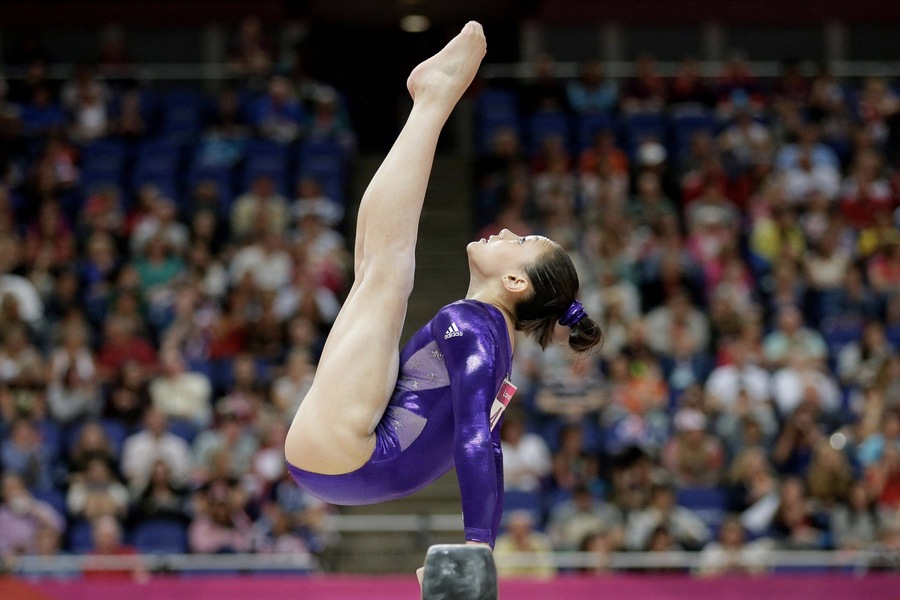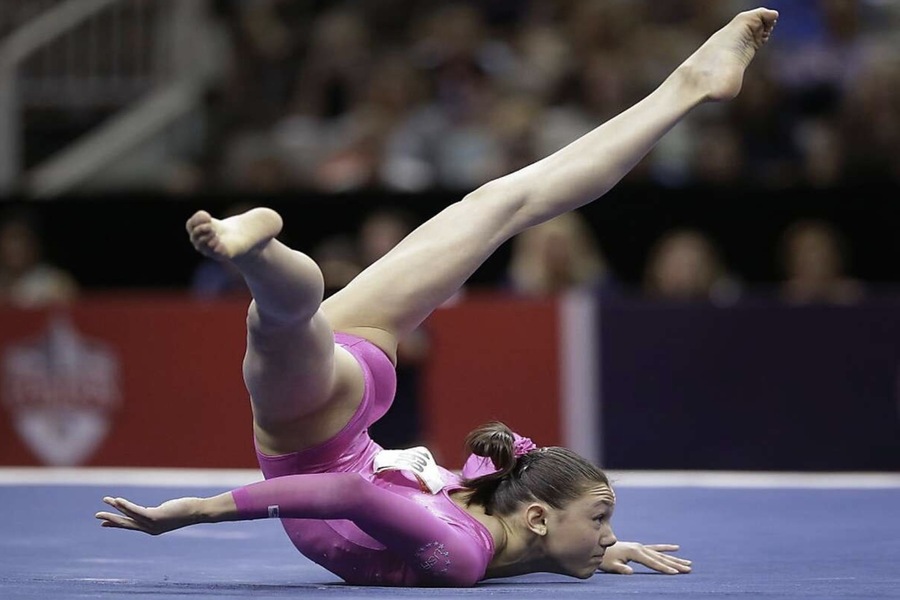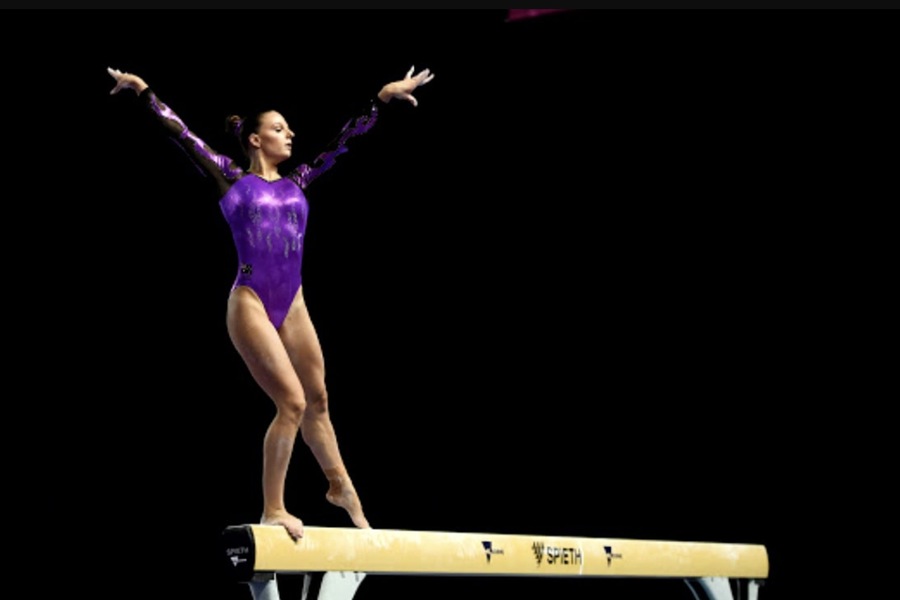Women’s artistic gymnastics stands as a dynamic and visually compelling discipline that blends athletic excellence with artistic flair. Athletes perform brief routines on various apparatuses such as the vault and uneven bars. Each routine undergoes assessment on factors like complexity, precision, and artistic interpretation, underscoring the significance of music and choreography in crafting a captivating and impactful performance.
Key Components and Apparatus Used
Women’s artistic gymnastics consists of four main apparatuses:
- Vault: An event of explosive power where gymnasts sprint towards a springboard and propel themselves over a vaulting table, executing twists and flips before landing.
- Uneven Bars: A demanding event that involves gymnasts swinging, releasing, and re-grasping two horizontal bars set at varying heights.
- Balance Beam: A narrow apparatus where gymnasts execute a sequence of acrobatic and dance maneuvers, demonstrating exceptional balance and precision.
- Floor Exercise: A meticulously choreographed routine performed on a spring floor, blending tumbling, dance elements, and expressive motions, frequently accompanied by music.
History
Women’s artistic gymnastics boasts a storied heritage originating in ancient Greece and has evolved significantly since then. However, its modern incarnation began to crystallize in the 19th century. The pivotal moment arrived in 1928 during the Amsterdam Olympics, when women were officially welcomed into the gymnastics arena. This historic decision marked a profound turning point, ushering in an era of advancements in both athletic prowess and artistic expression within the sport.
The inception of the first dedicated women’s artistic gymnastics studio in the early 1900s stands as a landmark event. This pioneering establishment provided a specialized training environment exclusively for female gymnasts. Its establishment not only facilitated the development of the sport among women but also laid a solid groundwork for its subsequent expansion and refinement.
Growing Popularity in Dubai
In recent years, women’s artistic gymnastics has seen a surge in popularity in Dubai. The city offers a range of artistic gymnastics classes, attracting aspiring gymnasts from across the region. This growing interest is supported by state-of-the-art facilities and professional coaching, making Dubai a hub for gymnastics enthusiasts.
Use of Music and Choreography in Women’s Artistic Gymnastics
In the mid-20th century, women’s artistic gymnastics saw a notable rise in the integration of music and choreography. The floor exercise, in particular, emerged as a canvas for gymnasts to showcase their artistic talents using meticulously chosen music and choreographed routines. This evolution continues to unfold, with music and choreography progressively enhancing the overall quality and impact of gymnastic performances.
Facts and Figures
In the 2020 Tokyo Olympics, over 50% of the floor exercise routines in women’s artistic gymnastics were accompanied by music that was specifically choreographed to highlight the gymnast’s strengths and style.
A survey conducted in 2022 revealed that 85% of professional gymnasts believe that music and choreography are crucial components of their routines, significantly impacting their performance and audience engagement.
Significance of Music and Choreography in the Sport
Music and choreography are not just embellishments; they are integral to the fabric of women’s artistic gymnastics. They help set the tone and mood for routines, allowing gymnasts to express their style and personality. The selection of music is a meticulous process, often involving collaboration between the gymnast, coach, and choreographer to ensure it complements the routine’s theme and the gymnast’s strengths.
Evolution of Music and Choreography in Women’s Artistic Gymnastics
Over the decades, the incorporation of music and choreography in women’s artistic gymnastics has undergone notable evolution. Initially, routines were straightforward and less coordinated with the music. Yet, as the sport advanced, choreographed routines grew in complexity and sophistication. This transformation is characterized by pivotal shifts and milestones in the sport’s development.
- 1960s: Introduction of more dynamic and expressive routines, influenced by contemporary dance and ballet.
- 1980s: Increased emphasis on artistic presentation, with gymnasts incorporating intricate dance elements into their routines.
- 2000s: Technological advancements allowed for more precise synchronization of music and choreography, enhancing the overall performance quality.

Importance of Music
Music plays a vital role in women’s artistic gymnastics, as it:
Sets the Tone and Mood
Music helps create the desired atmosphere for the routine, whether it’s energetic, dramatic, or lyrical.
Expresses the Gymnast’s Style and Personality
The choice of music reflects the gymnast’s individuality and artistic vision, allowing them to connect with the audience on an emotional level.
Selection Process for Music Pieces
The process of selecting music involves considering the routine’s theme, the gymnast’s strengths, and the desired emotional impact. It often requires input from multiple stakeholders, including the gymnast, coach, and choreographer.
Choreography in Gymnastics
Choreography in artistic gymnastics class involves the creation of movement sequences that align with the music and highlight the gymnast’s skills. It is a collaborative effort between the gymnast and choreographer, focusing on:
Expressing the Routine’s Theme
Choreography brings the routine’s theme to life, making it visually engaging and meaningful.
Maximizing the Gymnast’s Strengths
Choreographers design routines that showcase the gymnast’s unique abilities, whether it’s flexibility, strength, or artistry.
Ensuring Technical Precision
While artistic expression is important, choreography must also meet the technical requirements and scoring criteria set by the judging panel.
Interplay Between Music and Choreography
The interplay between music and choreography is essential in creating a cohesive performance. Music dictates the tempo and rhythm of the movements, while choreography translates the music’s emotional and thematic elements into physical expression. This synergy enhances the overall impact of the routine, making it more memorable and impactful.
Role of Coaches and Choreographers
Coaches and choreographers play a pivotal role in the success of a gymnast’s routine. The collaborative process involves:
- Developing the Routine: Coaches and choreographers work together to develop a routine that aligns with the gymnast’s strengths and the competition’s requirements.
- Fine-tuning the Performance: Continuous adjustments are made to ensure the routine is polished and seamless.
Profiles of Renowned Choreographers
Notable choreographers in women’s artistic gymnastics include Tatiana Tarasova and Eteri Tutberidze, who have contributed significantly to the sport’s artistic evolution.
Impact on Scoring and Judging
Music and choreography significantly influence the judges’ scores in women’s artistic gymnastics. The artistic components of a routine are evaluated based on criteria such as:
Artistic Impression
Judges assess how well the routine’s theme is conveyed through music and choreography.
Execution
The precision and fluidity of the movements in relation to the music are crucial for high scores.
Originality and Creativity
Unique and innovative routines that stand out are often rewarded with higher scores.
Psychological and Emotional Effects
The psychological impact of music and choreography on gymnasts is profound. Music can help gymnasts connect emotionally with their routines, enhancing their performance quality. It also serves as a motivational tool, helping them stay focused and energized during competitions.
Cultural and Artistic Expression
The influence of different cultures’ music and choreography in artistic gymnastics is evident in the diversity of routines performed at international competitions. Examples of routines that showcase cultural diversity include:
- Russian Gymnasts: Known for their classical ballet influences, Russian routines often feature elegant and graceful movements.
- American Gymnasts: Incorporate elements of contemporary dance and jazz, reflecting a more dynamic and energetic style.

Challenges and Controversies
Creating and executing music and choreography in women’s artistic gymnastics is not without its challenges. Common issues include:
Balancing Artistic and Technical Elements
Ensuring that routines meet the technical requirements while maintaining artistic integrity can be difficult.
Music Licensing and Rights
Obtaining the right to use certain music pieces can be a complex and costly process.
Controversies
Debates surrounding the use of music and choreography often center on issues such as cultural appropriation and the subjectivity of judging criteria.
Future Trends
Predictions and emerging trends in the use of music and choreography in women’s artistic gymnastics include:
Increased Use of Technology
Advancements in technology are expected to enhance the synchronization of music and choreography, leading to more precise and impactful performances.
Greater Cultural Integration
As the sport continues to globalize, there will likely be a greater integration of diverse cultural elements in routines.
Innovations in Choreography
New choreographic techniques and styles are expected to emerge, pushing the boundaries of artistic expression in gymnastics.
Conclusion
In women’s artistic gymnastics, the synergy between music and choreography holds vital importance, contributing significantly to both the artistic expression and competitive success of gymnasts. These elements elevate performances by enabling gymnasts to showcase their unique styles and connect deeply with their audience. As the sport progresses, the ongoing development and integration of music and choreography will continue to define and shape the future landscape of women’s artistic gymnastics.

I am an accomplished coder and programmer, and I enjoy using my skills to contribute to the exciting technological advances that happen every day at Oswald Tech.
